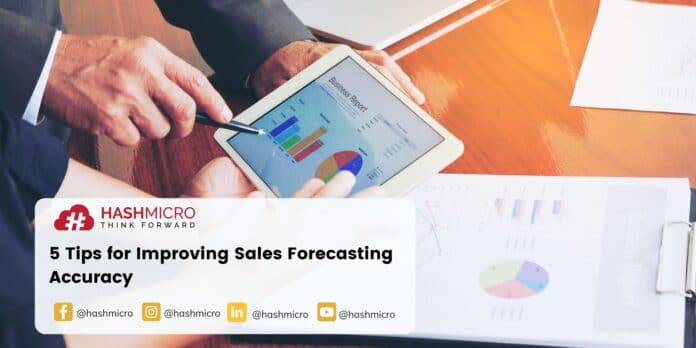Generating and managing sales are essentials in the sales management system. Sales forecasting plays an important role in the growth of your business. According to research from the Aberdeen Group, companies with accurate sales forecasts are 10% more likely to increase their income each year and 7.3% more likely to hit their targets. However, many companies still find it difficult to generate accurate sales forecasts until the end of the year. Optimizing sales and sales analytics is easier with the help of the right sales management software.
Improving the company’s sales strategies is certainly one of the indicators to improve sales forecasting. One way to improve these strategies is with a good and correct sales management system. Companies can determine sales targets and calculate sales commissions more accurately with the help of comprehensive sales management software. If you want to start implementing this software, you need to consider several things. One of them is considering the pricing scheme calculations to help you choose the best one for your business.

Table of Content
- Why is Sales Forecasting So Important?
- 1. Rely on Complete & Accurate Sales Data
- 2. Use an Effective Sales Management System
- 3. Keep Tabs on Factors Impacting Your Sales Forecasts
- 4. Focus on Demand, Not Supply
- 5. Involve Your Sales Reps When Forecasting Sales
- Conclusion
Why is Sales Forecasting So Important?
Sales forecasting is critical because it helps you find out how much income you can expect to generate in a certain period of time. The information in sales forecasts can be used to make intelligent decisions related to your sales process. Keep in mind that sales forecasts must be generated based on facts to be accurate. Reviewing your historical sales data can be a great starting point when forecasting future income, as it gives you facts, not just wishful thinking.
Sales forecasting allows you to figure out potential issues, so you can mitigate or at least reduce the impact of those issues. For example, when your sales revenue starts to drop, you will be able to find out the causes earlier before you experience further sales decline. You can make some improvements faster, like changing your promotion strategies or training your sales reps. Here are some ways to improve the accuracy of your sales forecasting:
1. Rely on Complete & Accurate Sales Data
First, prepare your sales data from the previous year. However, sales data alone is not enough. You need to ensure that it is complete and accurate. This will be a great starting point when drafting a new sales forecast for the following year. Use your historical sales data as a base, then consider all the factors that could help increase your sales. Find out if there are new trends relevant to your business, new opportunities in the market, rising demand for your product or service, and so on. Next, consider factors that could reduce your sales. Do you have new competitors in your industry? Are there regulatory changes that can affect your business offers? If so, then you need to reduce your expectations.
2. Use an Effective Sales Management System
There is no simpler way to improve sales forecasting accuracy than using an automated sales management system. Sales management software makes it easier for you to manage sales pipelines. You can monitor each process that you have to go through before reaching the closing stage. This allows you to estimate the time needed to close the deal and how much income you can expect to generate from prospects with similar interests or business types.
A good sales management system provides a forecasting feature that allows you to generate forecasts instantly with a high level of accuracy. However, it all depends on how detailed and often your sales reps update the sales stage information. Please note that not all sales management systems provide accurate forecasting features. Therefore, it is important to do some research to get the right sales management solution.
3. Keep Tabs on Factors Impacting Your Sales Forecasts
Before starting to predict future sales, there are several important factors that you should pay attention to. A few factors you should keep an eye out for when forecasting sales include:
Internal Factors
Hires and Fires
When the number of your sales reps decreases due to layoffs, this could reduce your sales revenue. However, when the number of your sales reps increases, you can expect revenue growth in the next period.
Regulatory/Policy Changes
Your sales regulatory or policy changes can also affect your income. For example, if you implement a four-month clawback on commission, your income will most likely decrease. Because your sales reps will only sell to the most potential prospects. However, your profits will increase in a quarter as the number of prospects increases.
Location Displacement
When you move your business location from your current location to another, there will be some adjustments needed. Your sales reps will need time to familiarize themselves with the new area and build their pipeline, so you have to prepare yourself for a temporary decline in income.
External Factors
Competitive Changes
It’s no surprise that what your competitors are doing could affect your income. Therefore, it is important to know what they do to increase their sales. This way, you can develop better strategies for recovering your sales revenue.
Economic Conditions
When the economy is strong, buyers tend to invest in their businesses. However, when the economy is weak, the sales cycle usually takes longer and buyers need more consideration for every purchase.
Market Changes
Make sure that you always know what your prospective customers want. You need to know if there is still a high demand for your service or product. If the demand is low, then you might be interested in adding something trending to your sales, discounting your service or product, or using bundling techniques.
Legislative Changes
New laws and mandates could increase or reduce the profitability of your business – either by creating a demand for your product or making prospects reluctant to buy something new.
Seasonality
Your customers may be more likely to buy at certain times of the year. For example, adults who have children usually tend to make more purchases during the back-to-school season and reduce their spending throughout the rest of the year.
4. Focus on Demand, Not Supply
When forecasting sales, don’t just focus on the supply of your product or service. Focus more on-demand, then account for supply. This will help you provide the right inventory. You will be able to prevent both shortages and excess inventory, allowing you to save even more money. For example, you usually provide 200 computers every month, but the data shows that there will be a demand for 300 computers next month. Thus, by forecasting in advance, you can have enough time to order more computers to meet this demand.
5. Involve Your Sales Reps When Forecasting Sales
Your sales reps are the people who understand your customers best. Therefore, ask them to be involved when forecasting sales. Make sure they regularly enter accurate data related to sales progress and meeting summaries into the CRM app in a timely manner. Ask them also to develop sales strategies for the next period based on preferences and suggestions from the existing clients.

Conclusion
Generating accurate sales forecasts is clearly not easy, because the results will always be a little different from what was expected. However, with clean sales data and the right methods, you will be able to generate near-perfect sales forecasts. Make sure they always enter accurate data regarding sales status and meeting summary on time into the integrated CRM application. Also, ask them to jointly develop a sales strategy for the coming period based on the preferences and suggestions of current clients. If you are interested with the CRM system, you can try out this free demo.




































